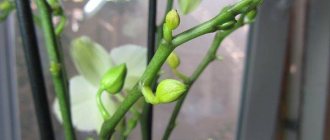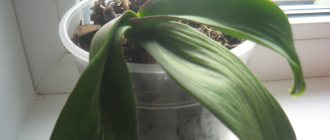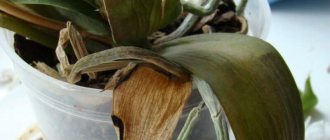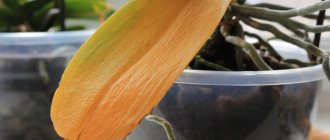When a store sells indoor orchids at a price 2-3 times lower than usual or friends offer to pick up a drying plant for free, it’s hard to resist. Even if the orchid’s leaves turn yellow and begin to dry, and the roots turn brown, such a plant can be saved. You just need to transplant it correctly. Indoor orchids are rather capricious plants. This is due to the fact that their homeland is a tropical jungle. It is quite difficult to maintain a regime suitable for a flower in indoor conditions.
Improper care can lead to the fact that within a few weeks you will have to think about how to revive the orchid from the consequences. Very often, orchids begin to have difficulties with roots. Don't be discouraged. A withered plant, even with rotten roots, can be revived. In order to understand how to resurrect a dying plant, you need to understand the factors of the problems. Often, improper care is to blame for the roots rotting. Orchid loves diffused light. Very often, difficulties with the root system of orchids begin in the autumn-winter period. Therefore, from September to March you need to take extremely close care of the plants. In the warm season, actively growing, flowering orchids feel comfortable in natural conditions, easily tolerating the lack of lighting, heating and additional air humidification. What is the reason that orchids die at home, and how to save a beautiful flower?
Latest articles about gardening
Pickling cabbage in February 2022 according to the lunar calendar
How to treat pepper seeds with hydrogen peroxide before planting seedlings?
Treating pepper seeds with potassium permanganate before planting seedlings
How to understand that something is wrong with an orchid?
The orchid will definitely give you warning signals and, first of all, these will be:
§ dried and withering leaves;
§ poor growth.
In this case, only immediate replacement of conditions and resuscitation can help and give the flower a second life. The first thing to do before resuscitating an orchid is to check the roots. Ideally, the shoots should be light in color. On top they are covered with a greenish substance - velamen. The shell performs several functions. Protects the thin, long root from various damages and is involved in “feeding” the plant. Small appendages are visible to the naked eye. They are the ones who absorb water from the substrate.
Incorrect temperature conditions for orchids
When an orchid stands in a room with a very high temperature for a long time or is exposed to direct sunlight, the surface of the flower heats up and it begins to lose water. Because of this, the foliage of the plant begins to wither and dry out. In this case, you need to: remove the orchid for two to three hours in a dark place in the room, let it settle. Please note: it is strictly forbidden to water or spray the plant without allowing it to “rest” in the shade. This can lead to the death of leaf tissue; After the flower has settled, you can water it and spray the leaves. You should not expect the plant to immediately revive and recover - this will take at least a couple of days.
Why do orchid leaves turn yellow?
Yellowing and drying of orchid leaves can be caused by various reasons. Usually this is a violation of the conditions of maintenance when the leaves fall off due to the death of the roots.
First of all, check the condition of the root system - it is very easy to distinguish living roots from dead ones in orchids. The roots of the orchid have rotted, if they have turned brown, lost their elasticity, and have crumpled, soaked areas. Viable orchid roots should be light in color (usually green
If your orchid's leaves have turned yellow, flabby, and limp, it may have suffered from overheating. Where is the pot with your plant? If it is on a windowsill, next to a window that is not covered with blinds or curtains, or in close proximity to a central heating radiator, then it is likely that the plant is sick from excessive heat. Note that the leaves will not recover immediately, but after three to four days with proper care. To avoid repeated overheating, change the location of the flower pot. Remember that the orchid does not like scorching sunlight, so it is better to shade it or place it some distance from the window.
An orchid can be saved, even if it is left with almost no roots. To do this, you need to replant it, first removing dead leaves and roots.
Is it possible to influence the situation and how to do it?
If, as a result of soil compaction, overheating of the roots occurs, and as a result, the flowers on the orchid wilt, then it is necessary to remove the affected plant from the soil and inspect the root system.
When subsequently filling the pot with soil, make sure that the air circulation is not disrupted.
How to save an orchid - method 1
If the orchid has enough living roots left, then after cleaning the root system it can be planted in a small pot filled with substrate. Since weakened roots will not allow the orchid to gain a sufficient foothold in the pot, it needs to be further strengthened at first. Like all patients, the injured orchid needs to be provided with gentle conditions: place it in a well-lit place, but protected from direct sunlight, and ensure proper drinking conditions. It should be remembered that weakened roots will not be able to fully absorb moisture from the substrate, so you need to water the orchid very carefully, slightly moistening the substrate with a spray bottle. Bottom watering of the orchid, when water is poured into a saucer in which the pot stands, gives excellent results in restoring the root system.
We recommend reading our other articles
Planting seedlings in boiling water
How to plant carrots without thinning? Video
Caring for raspberries in spring pruning video
Pruning grapes in spring for beginners scheme
What's next?
After 2-3 weeks, dormant buds should awaken on the stump, from which children will subsequently appear. If this does not happen, while the roots are alive, then you can give the orchid a dry period. The fact is that in nature, babies appear on orch trees only during periods of drought.
Give your orchid a shake-up - stop watering for 7-10 days. It helped my “patient”! A tubercle appeared under the dry scales, from which a small cute baby later formed.
Baby care
If the baby has formed on the side surface of the stem, then wet sphagnum moss should be placed under it to stimulate the formation of aerial roots. It is recommended to spray the moss with a root solution.
The baby may be radical. In this case, you need to carefully move the substrate and replace large fragments with smaller ones. It is important to give the child the opportunity to develop in the air.
At this stage, you can add a little nitrogen fertilizer to the vitamin cocktail for the development of leaves in the baby.
Rooting baby
As soon as the baby has roots 4-5 cm long, it is planted in a separate container. Orchid growers call it a “maternity house” - it’s a small transparent container onto which the top of a plastic bottle without a lid is placed. A constant temperature and humidity are maintained inside the bottle, which promotes rapid growth of the baby's roots.
With proper care, in a year the baby will turn into a young orchid, ready to delight its savior with long flowering.
How to save an orchid - method 2
If the orchid has no living roots left at all, then it is best to revive it with the help of a greenhouse. To do this, a layer of drainage - expanded clay - is poured into a spacious container, on top of which a layer of moss is placed. It is better to buy moss at a flower shop, as wild moss can be infected with parasites and pests. The damaged orchid is placed on top of the moss, covered with a plastic or glass cap, and conditions of high humidity and temperature are created in the greenhouse. After 10-14 days, the first roots will appear on the orchid. When the roots reach 3-4 cm, it can be planted in a regular substrate.
Reasons for orchid drying out
There may be several of them. An orchid is so different from everything that surrounds us that tropical exotics are often destroyed by our love and care. We water it with all our hearts, feed it, put it in the sun, ventilate it... That is. We do exactly what is strictly contraindicated for orchids!
Orchids especially often suffer from excessive watering and sprinkling. The roots rot from excess moisture, and water accumulated in the axils of the leaves leads to fungal diseases.
And pests and diseases do not sleep.
Fusarium leaves behind especially catastrophic consequences. With this disease, the leaves begin to turn yellow at the stem, dry out and fall off. All that remains of the orchid is a stump.
The same stump remains after the plant is rejuvenated, as a result of which the orchid is “headed off” - the young top with 3-4 aerial roots is cut off, which is planted in a new container.
One way or another, you have an orchid, from which only one stump with one or two slightly living leaves remains. Is it possible to save this disabled person?
How to save an orchid - method 3
You can revive an orchid using ordinary water. To do this, it is placed in a container of water so that only the very tip of its lower part touches the water. After 12 hours, the water is drained, and after another 12 hours, it is poured again. The air temperature should be at least +25° C. The appearance of roots with this method should be expected after 6-10 weeks, but sometimes this period can extend up to six months.
We recommend reading our other articles
Seedlings in snails and diapers Yuliya Minyaeva leeks
Peach pruning in spring video for beginners
How to feed an orchid at home? How to feed an orchid at home? home conditions?
How to make a flower stand with your own hands
Unsuitable soil for orchids
In fresh substrate, the roots and above-ground parts of the plant receive the necessary amount of oxygen. Over time, air permeability deteriorates as the substrate becomes denser. All this is reflected in the general condition of the phalaenopsis orchid. To prevent this, you need to periodically change the substrate. Rapid drying of the soil coma is another reason for the wilting of leaves in orchids. All this happens due to the incorrect composition of the substrate. Its main component should be pine bark, which has increased moisture and breathability, which is very necessary for the plant. Pine bark should be chopped into pieces about 1-2 cm in size.
Using growth regulators when caring for an orchid
Experienced gardeners recommend using growth regulators that help strengthen the plant’s immune system. The most commonly used are “Epin” (or otherwise “Epin-Extra”), as well as “Zircon”. These drugs help the orchid regain its strength. Epin should be diluted in a dosage of 1 liter - 1 drop. You can soak the plant in this solution for 20 minutes to 2 hours. But remember that growth regulators themselves are not a magic panacea for all orchid diseases. In order for the plant to feel good, it is necessary to create favorable growing conditions for it, including maintaining high air humidity and sufficient lighting in the room. We hope you now know how to revive a phalaenopsis orchid. Care for the plant wisely, observing all agrotechnical growing rules, avoiding overwatering, hypothermia or overheating.
Why buds:
Are they not blooming?
reasons for not blooming:
- Lack of lighting;
- Application of fertilizers (during the period of budding and flowering, phalaenopsis is not fed);
- Ingress of moisture during spraying;
- Overwatering;
- Hot room temperature;
- Rearrangement during flowering period, etc.
Are they falling off?
In phalaenopsis, at the genetic level, flowers bloom with the onset of the dry summer period. But this is in the tropics.
It is winter here at this time, so for orchids in our conditions, a certain stress .
Although there are many reasons for falling off, they are mainly caused by stressful situations .
Unsuitable soil for orchids
In fresh substrate, the roots and above-ground parts of the plant receive the necessary amount of oxygen. Over time, air permeability deteriorates as the substrate becomes denser. All this is reflected in the general condition of the phalaenopsis orchid. To prevent this, you need to periodically change the substrate. Rapid drying of the soil coma is another reason for the wilting of leaves in orchids. All this happens due to the incorrect composition of the substrate. Its main component should be pine bark, which has increased moisture and breathability, which is very necessary for the plant. Pine bark should be chopped into pieces about 1-2 cm in size.
How long does an orchid “go on vacation”?
Alas, there is no clear answer to this question in principle. As a rule, it all depends on the type of orchid, its living conditions, etc. For example, Phalaenopsis
If handled properly, they can bloom after about three months of rest.
Please note that in many respects the subsequent flowering of an orchid is directly related to the correct care of this capricious beauty in the period after flowering. The orchid has faded, what should I do next?
Special attention
It is worth paying attention to
flower pruning
, because this procedure has a lot of nuances and subtleties.
Lack or excess of moisture for an orchid
Insufficient watering. Orchid is a tropical plant. For its healthy growth, warmth and sufficient soil moisture are necessary. With insufficient watering, the amount of moisture in the leaves is reduced, and the plant becomes lethargic and lifeless. When watering, you should be guided not by specific time intervals at which the plant is watered, but by the specific condition of the soil in the pot. The frequency of watering is influenced by many factors: pot size, soil looseness, ambient temperature. You should be guided by the rule - if the upper layers of the soil begin to dry out, the orchid needs watering.
Excess moisture and too dense soils. The orchid loves a humid environment, but air must always circulate between the roots of the plant, i.e. the substrate should be quite loose. Excess moisture makes roots vulnerable to rot.
Improper feeding of orchids
Developmental pathologies in domestic orchids can appear both from overfeeding with fertilizers and from their deficiency and, as a rule, are determined by the appearance of a marble pattern on the leaves (red, light green, white yellow, etc. spots on the dark green leaf blade). Oddly enough, in both cases, the orchid equally experiences a delay or disruption in development, the growth of curved leaves and refusal to flower, but the treatment for these conditions, of course, is different, so it is very important to distinguish between overfeeding and under-fertilization. The most common situations where fertilizer supply is disrupted are overfeeding with nitrogen and iron deficiency. The plant usually “signals” about an excess of nitrogen fertilizers gradually and for a long time (over 2 - 3 months): at first, larger and darker leaves actively grow, then they begin to deform (a wavy edge appears), flowering stops or much fewer flowers are formed (1 - 2 instead of 10 - 20), the pseudobulbs thicken and change color, and finally, the pseudobulbs and leaves begin to crack. Unfortunately, beginners unknowingly mistake the first signs of overfeeding with nitrogen for the normal active development of the orchid, and the alarm begins to sound already at the final stage of the appearance of cracks. Despite the fact that it is quite possible to restore the normal functioning of such plants, many of them may completely refuse to flower over the next 2 to 3 years, even if the fertilizer doses are adjusted.











